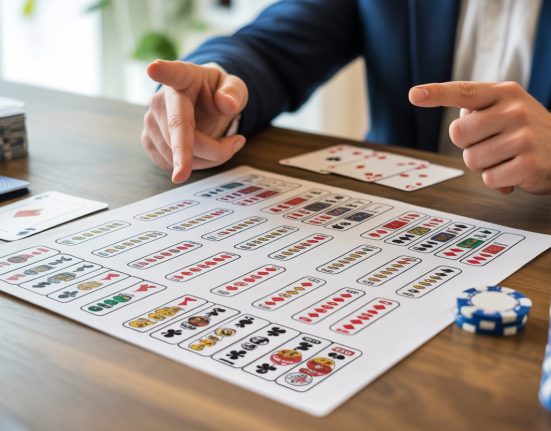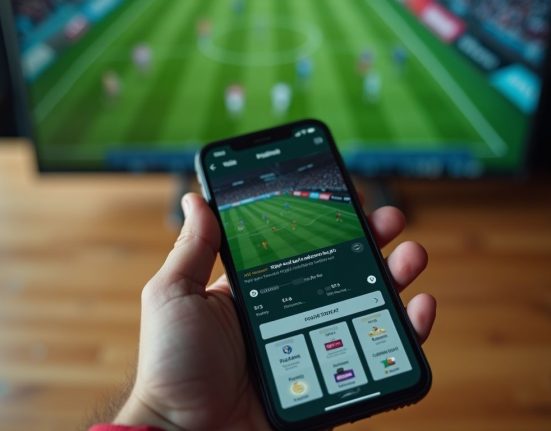Many sports fans struggle to make sense of the changing numbers during live games. In-play odds shift rapidly as games unfold, making quick decisions vital for successful sports betting.
This guide will teach you how to read in-play odds and make smarter wagers while watching your favorite sports. You’ll gain an edge over other bettors.
Understanding In-Play Odds

In-play odds change constantly as a game unfolds, reflecting the current state of play in real-time. These dynamic betting options let you place wagers after a match has started, with odds that shift based on scores, injuries, and momentum changes.
What are In-Play Odds?
In-play odds represent the live betting values that change during a sports event. These dynamic figures shift based on game action, score changes, and time remaining. Unlike pre-game odds that stay fixed, in-play odds update every few seconds to reflect the current game situation.
Sports bettors watch these numbers closely to find value bets as the action unfolds. The odds display in various formats including American (-110), decimal (1.91), or fractional (10/11) styles depending on your sportsbook preference.
Live betting turns every moment of a game into an opportunity. The smart bettor reads these shifting odds like a weather vane pointing toward value.
How are In-Play Odds Different from Pre-Match Odds?
In-play odds change rapidly based on what happens during a game, unlike pre-match odds that stay fixed once the event starts. Pre-match odds get set hours or days before the game and reflect bookmakers’ predictions about the outcome.
These initial odds factor in team statistics, player injuries, and historical data. Once the game begins, these odds lock in for anyone who placed bets early.
Live betting odds shift every few seconds as the action unfolds on the field. A touchdown in football or a goal in soccer can cause dramatic shifts in the betting lines. Sportsbooks use complex models to adjust decimal, fractional, or American odds based on score changes, time remaining, and momentum shifts.
This dynamic nature creates both risks and chances for bettors to find value bets that pre-match odds cannot offer. The fast pace requires quick decisions from punters watching the game closely.
Types of Betting Odds
Bettors need to understand the three main odds formats used across global sportsbooks. Each format displays the same betting information but uses different numerical systems that appeal to specific regions and betting markets.
American Odds
American odds stand as the standard format used by U.S. sportsbooks. They appear with either a plus (+) or minus (-) sign in front of a number. A minus sign shows how much you need to bet to win $100.
For example, -110 means you must wager $110 to win $100. A plus sign indicates how much profit you’ll make on a $100 bet. If you see +150, a $100 bet will yield $150 in profit. I once placed a $50 bet on a football game with +200 odds and won $100 in profit, making my total payout $150.
These odds shift during live games based on what happens on the field. Teams that score early often see their odds shorten, while teams falling behind get longer odds. The movement offers smart bettors chances to find value bets with higher payouts.
American odds might seem tricky at first, but they quickly become second nature after placing a few wagers. Many sports betting platforms now offer tools that convert between different odds formats to help new players understand potential payouts.
Fractional Odds
Unlike American odds, fractional odds show up as fractions like 5/1 or 9/2 on betting slips. These odds came from British bookmakers and remain popular in UK sportsbooks today. The first number shows your profit, while the second number represents your stake.
For example, 5/1 odds mean you win $5 for every $1 you bet, plus getting your original stake back. Many bettors find these odds easy to calculate potential payouts quickly. Fractional odds give you a clear picture of risk versus reward at a glance.
You can convert fractional odds to find their value in other formats. A 3/1 fraction equals +300 in American odds or 4.0 in decimal format. British racing fans often use these odds for horse racing bets.
The odds movement during live events tells you how teams perform in real-time. Sports betting platforms display these fractions prominently, helping beginners understand their potential returns before placing wagers.
Decimal Odds
Decimal odds show the total payout you’ll receive for each dollar wagered. For example, odds of 2.50 mean you’ll get $2.50 back for every $1 you bet, which includes your original stake plus $1.50 profit.
Many European sportsbooks and betting exchanges use this format because it’s easy to understand. The higher the decimal number, the less likely the outcome and the bigger your potential payout.
Decimal odds simplify calculations for multiple bets too. You just multiply the odds together to see your potential return on parlay bets.
Sports bettors often prefer decimal odds for their clarity in showing total returns. Unlike other formats, decimal odds don’t require extra math to figure out your winnings. The odds conversion between decimal and other formats is straightforward with most online casinos offering tools to switch between them.
Bettors who track expected value find decimal odds helpful because they can quickly compare the bookmaker’s implied probability against their own predictive models.
How to Interpret In-Play Odds
In-play odds change fast as the game unfolds, showing you real-time betting chances based on what’s happening. You’ll need to grasp how positive and negative numbers work and watch how odds shift during key moments to spot good betting values.
The Meaning of Positive (+) and Negative (-) Odds
American odds use plus and minus signs to show your potential profit and risk. Positive odds (+150) tell you how much you’ll win on a $100 bet. For example, a +150 wager pays $150 profit on a $100 stake.
Negative odds (-200) show how much you need to bet to win $100. A -200 line requires a $200 bet to earn $100 in profit. These symbols act as quick guides to value bets during live sports action.
I’ve placed many in-play wagers where odds shifted from -110 to +120 after a team fell behind, creating better value. The plus/minus system helps bettors gauge risk versus reward before wagering money on NFL betting or other sports events.
Adjustments in Real-Time Based on Game Progress
In-play odds shift constantly as games unfold. These real-time changes reflect what happens on the field or court during live sports events.
- Score changes cause immediate odds adjustments. A team that scores will see their odds shorten while the opponent’s odds lengthen.
- Time remaining affects betting values significantly. As the clock winds down, the leading team’s odds typically become shorter.
- Player injuries or substitutions trigger quick odds movements. Bookmakers react swiftly when key players leave the game.
- Momentum shifts prompt oddsmakers to recalculate probabilities. A team on a scoring run often sees their odds improve rapidly.
- Weather changes during outdoor events impact live odds. Sudden rain or wind can alter game conditions and betting values.
- Possession changes influence moneyline odds in sports like football. Teams with the ball in scoring position get more favorable odds.
- Red cards or penalties in soccer dramatically shift the betting market. Playing with fewer players greatly reduces a team’s chances.
- Statistical trends during play guide sportsbook adjustments. Teams shooting well above their average may see odds tighten.
- Crowd energy sometimes factors into odds calculations. Home teams rallying with crowd support might get improved odds.
- Point spreads fluctuate based on scoring patterns. Close games tend to have tighter spreads as they progress.
Understanding these real-time adjustments helps bettors spot value bets during live games. Next, we’ll explore practical tips for reading in-play odds effectively and making smart wagering decisions.
Tips for Reading In-Play Odds Effectively
Success in live betting depends on your skill to spot odds changes quickly. Smart bettors watch for sudden shifts that signal value opportunities before the sportsbook adjusts.
Monitoring Odds Movement
Odds movement gives you valuable clues about how bookies view a game as it unfolds. Smart bettors track these shifts closely using odds comparison tools or sportsbook platforms. I’ve found that sudden drops in decimal odds often signal breaking news like player injuries or lineup changes.
These quick shifts create perfect spots for value bets if you act fast. Most online gambling sites now offer live graphs that display odds trends over time, making pattern recognition much easier.
Sports betting success depends on your ability to spot odds that don’t match the actual game situation. The gap between what you see on the field and what the odds show creates profit opportunities.
During NFL betting, I’ve noticed odds move too dramatically after early touchdowns, overreacting to single plays. This happens because sportsbooks adjust quickly to heavy betting on one side rather than actual game developments.
Tracking these movements helps you avoid wagering money on poor-value bets and find spots where the odds haven’t caught up to reality.
Using Odds to Identify Value Bets
Value bets exist when sportsbook odds offer better returns than the actual probability suggests. Smart bettors compare their own calculated chances against the bookmaker’s odds to spot these opportunities.
For example, if you think a team has a 50% chance to win (true odds of 2.0 in decimal format), but the sportsbook offers 2.5, this represents value. The key lies in finding these gaps between your assessment and the market odds.
Tracking odds movement helps reveal value in real-time during games. Sudden shifts in moneyline odds or point spreads often signal important events that bookmakers might overreact to.
Professional gamblers focus on these moments to place strategic wagers before the odds correct themselves. This approach works across NFL betting, casino table games, and other wagered money opportunities.
The goal remains finding situations where the potential reward outweighs the calculated risk.
Conclusion
Reading in-play odds takes practice, but the skills you gain will boost your betting success. Start with basic odds formats, watch how they shift during games, and spot value when odds don’t match the actual game situation.
Smart bettors track odds movements to find the best moments to place wagers. Sports betting should be fun first, with potential profits as a bonus. Your new knowledge of in-play odds creates opportunities for more strategic and enjoyable sports wagering experiences.
FAQs
1. What are the different types of betting odds I should know for in-play betting?
The three main types are American odds (moneyline), fractional odds, and decimal odds. Each format shows potential winnings differently, with American odds being most common in the US, fractional odds in the UK, and decimal odds in Europe and Australia.
2. How do I read point spread odds during a live game?
Point spreads show the margin a team must win by or not lose by more than. The favorite has a minus sign, while the underdog has a plus sign. These numbers change constantly during in-play betting as the game progresses.
3. Can I convert between different odds formats?
Yes. Most sportsbooks and gambling websites offer built-in odds conversion tools. Understanding how to switch between American, decimal, and fractional odds helps you compare values across different platforms.
4. How do Vegas odds differ from other sportsbook odds?
Vegas odds often set the standard that other books follow, but online gambling in New Jersey and other states may offer slightly different lines. These small differences create opportunities for smart bettors to find better values.
5. What basic strategy should I use when reading live betting odds?
Watch for sudden odds shifts that might signal breaking news or changing game conditions. Compare the current odds to pre-game lines to spot value, and never chase losses with risky bets. Remember that managing your bankroll is just as important as understanding the odds.













Leave feedback about this